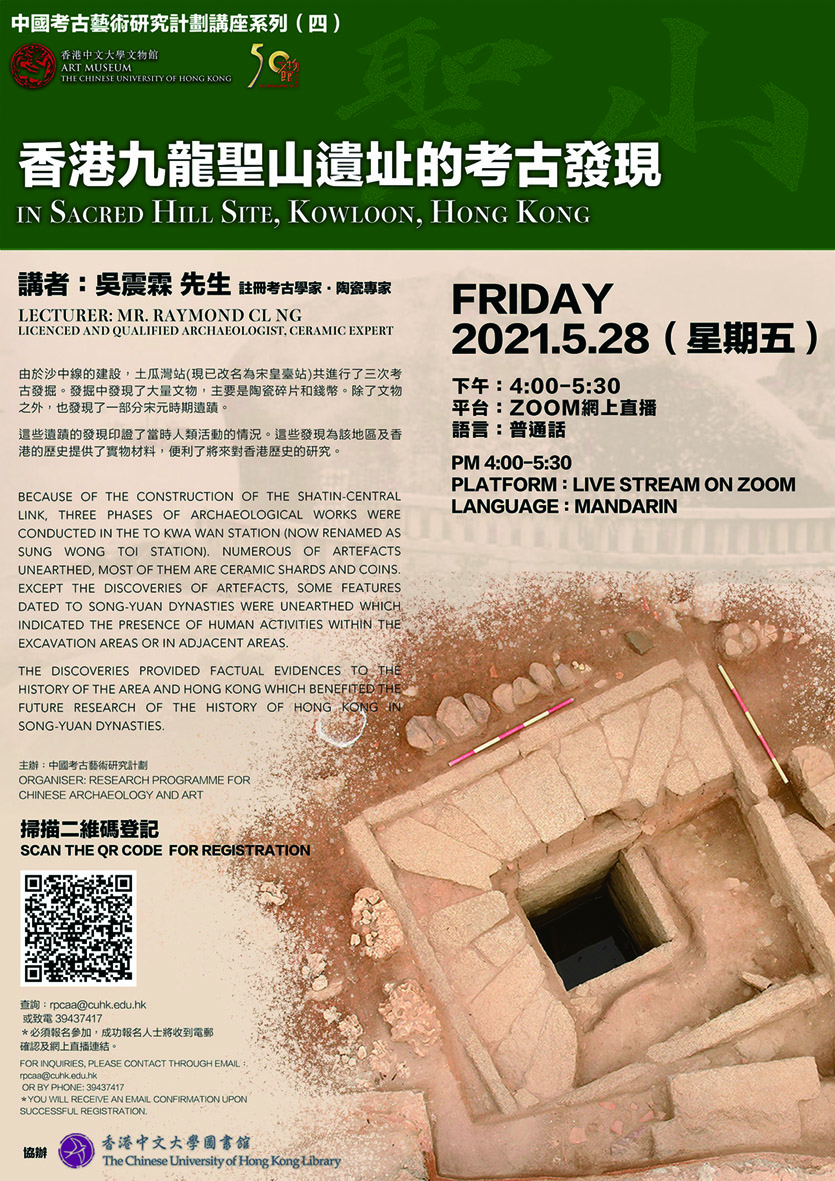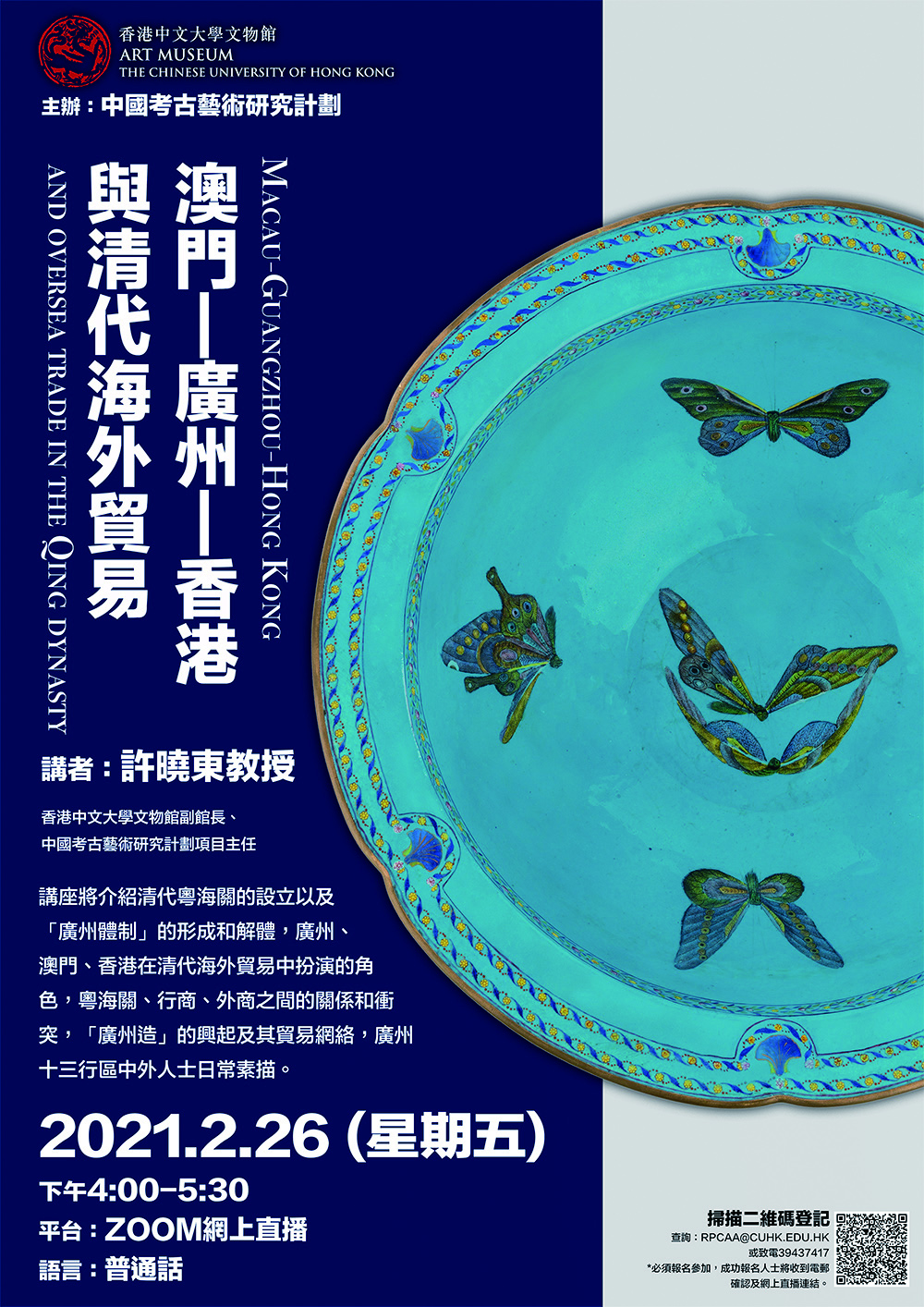It was the very first lecture of the series. With the participation from the local and overseas community, the highest online attendance count peaked at 90 people.
RPCAA Online Lecture Series (2)Porcelain Commissioned by the Portuguese and the Beginning of Sino-European Maritime Trade

The lecture was held by Dr Wang Guanyu, Samantha, the Associate Curator of the Research Programme of Chinese Archaeology and Art and the Art Museum, on 26 March 2021. The content mainly revolved around the Age of Discovery, which began in Europe during the 15th century. With the support of the aristocrats and royal families, the fleets from different countries had been actively exploring by sea and expanding their knowledge of the world. They continued to advance eastward, searching for new trading routes and resources. In the early 16th century, the Portuguese became the first to arrive in China and opened the prelude to the “golden age” of Sino-European maritime trade.
Before the opening of Macau (1553), the Portuguese were active along the southeast coast, conducting illegal transactions with Chinese smugglers. The unauthorised trade record of voyages and details were unclear in the literature, but some traces could be found on the export commodities, such as Chinese export porcelain. Porcelain custom-made for the Portuguese, a vital type of ceramic(s) in the trade, was selected as a case study in this report. The situation and motivations of the earliest participants in the Sino-Portuguese trade had been analysed by examining the key patterns, decorative elements and inscriptions on the porcelains. Besides, the quantities, shapes, patterns, and other characteristics of the existing porcelain would be investigated to determine the commissioning process and trade mode during the early 16th century. The project aimed to complete the history with articles of cultural properties and reconstruct some relatively unknown historical stories of the beginning of the Sino-European maritime trade.
The first lecture received a great response, and the second one was even better-- The audience actively involved in the Q&A session after the meeting. They were excited and eager to learn more about the topic and exchange their ideas.
RPCAA Online Lecture Series (3)The Encounter Between the Qing Imperial Workshops and the Canton Trade

The lecture was delivered on 30 April 2021 by Dr Chou Yingching, Joyce, a Postdoctoral Fellow of the programme. During the event, she discussed the giving and receiving gifts events of the Qing Dynasty emperors and how it brought a massive influence on the unique international trade network in Guangdong and Guangdongmade products.
The Qing Dynasty had achieved the peak of Trading with the western world in Chinese history. During the High Qing era, the three emperors, Kangxi, Yongzheng, and Qianlong, all obtained the latest news and products from Europe through the Guangdong customs, the foreign merchants of the 13th Guangdong branch, and the ministers of Guangdong and Guangxi. They are all eligible groups for tributary in the Guangdong district. Apart from his personal use, the emperor would reward these Western goods to his ministers on special occasions. Based on the advantages of trading directly with the Westerners, Guangdong has developed its unique style of art. Canton goods were not only popular in the Western market but also favoured by the Beijing court. Crafters in Canton were often recruited to work as errands at the palace workshop, thereby affecting the craftsmanship and design style in Beijing. In the late Qing period, some workshop in Guangdong were even contracted by the Qing Court.
The interaction of China and the West, which benefited from the trading business in Guangdong, was not limited to plain business activities, it involved religious activities, personal interests and preferences of the emperor, and the attitudes of local officials in Guangdong. The Sino-French trade was one example. It started with an exchange of gifts between Emperor Kangxi and Louis XIV, at the same time, it involved complicated power struggles between the Holy See, the French court, Jesuit missionaries, French merchants, and local officials in Guangdong. The collision between these groups shaped the form of Sino-French trade in the eighteenth century, and this will be one of the main focus of the research project about Canton trading in the Qing dynasty.
The lecture series had generated rave reviews. Over 300 people had registered for this talk, with the highest attendance being 197 people. The audience had expressed a keen interest in royal artefacts. During the Q&A session, the response from the crowd was excellent.
RPCAA Online Lecture Series (4)Archaeological Discoveries in Sacred Hill Site, Kowloon, Hong Kong

Mr Raymond Ng, a local archaeologist working at the forefront was invited for the lecture on 28 May 2021. Mr Ng is a veteran ceramic expert who has been doing local large-scale archaeological fieldwork for a long time. SCL (Shatin to Central Link) is one of the most famous fields within Hong Kong, with a history of critical archaeological discoveries.
Due to the construction of the Shatin-Central Link, three phases of archaeological excavation were conducted in the To Kwa Wan Station (now renamed as Sung Wong Toi Station). Numerous artefacts were unearthed, most of them being ceramic shards and coins. Apart from the artefacts, some historical remains that dated to Song-Yuan dynasties were also unearthed, which indicated the presence of human activities within the excavation areas or in adjacent areas.
The discoveries provide factual pieces of evidence to the history of the area and Hong Kong, which benefit future research of the history of Hong Kong in the Song-Yuan dynasties. This lecture was also invited by Radio Television Hong Kong to be broadcasted on their programme "University Knowledge Platform”.
















